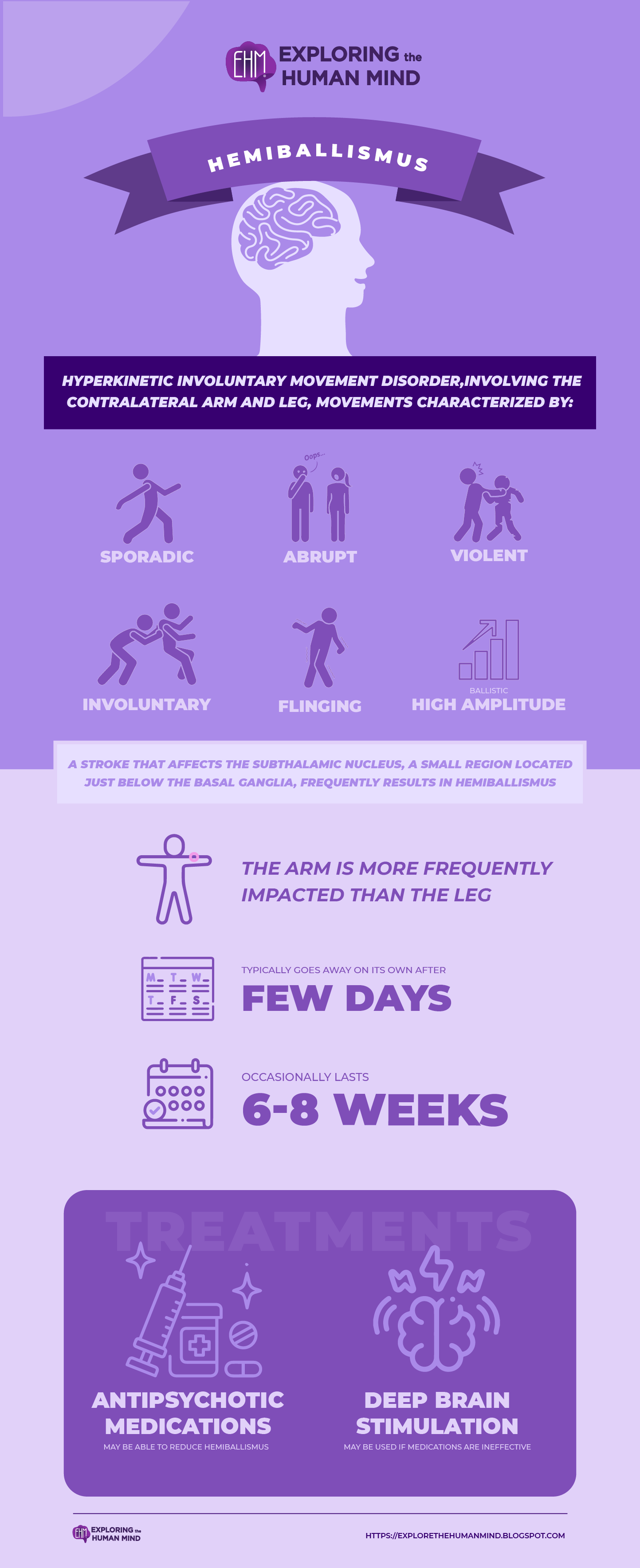Hemiballismus
Similar to Huntington's disease chorea, dopaminergic medication-induced chorea in Parkinson's disease can occasionally appear to become ballistic, but in these instances, the movements affect both sides of the body.
Hemiballismus is a hyperkinetic involuntary movement disorder characterized by sporadic, abrupt, violent, involuntary, flinging, or ballistic high amplitude movements involving the contralateral arm and leg. This disorder is brought on by dysfunction in the contralateral side's central nervous system. In addition to reviewing the aetiology, assessment, and management of hemiballismus, this activity also emphasises the importance of the interprofessional team in identifying and treating patients with the condition.
A stroke that affects the subthalamic nucleus, a small region located just below the basal ganglia, frequently results in hemiballismus. The subthalamic nucleus aids in the regulation of voluntary motion.
An affected side of the body has hemiballismus. The arm is more frequently impacted than the leg. Because the limb may flail out of control when someone tries to move it, hemiballismus can be momentarily incapacitating.

vectors by Freepick; graphic design by Vadot
Hemiballismus occasionally lasts for 6 to 8 weeks, but it typically goes away on its own after a few days. Antipsychotic medications may be able to reduce hemiballismus. Deep brain stimulation may be used if medications are ineffective. The basal ganglia are surgically implanted with tiny electrodes for this procedure. The electrodes can help relieve symptoms by sending tiny amounts of electricity to the region of the basal ganglia thought to be in charge of hemiballismus.
If the underlying disorder is treated, hemiballismus has a good prognosis with symptomatic and pharmaceutical treatment. An interdisciplinary team of primary care, specialists, and subspecialty clinicians (general neurology, neurosurgery, movement disorder, neuroimmunology specialist, genetics, oncology, infectious disease, rheumatology, palliative care, social workers, physical/occupational/speech therapists, behavioral health, and nursing coordinators) should collaborate in the case of noncurative aetiologies, such as those seen in neurodevelopmental disorders.
Reference:
Hawley, J. S., & Weiner, W. J. (2012). Hemiballismus: Current concepts and review. Parkinsonism & Related Disorders, 18(2), 125–129. https://doi.org/10.1016/j.parkreldis.2011.08.015
Gonzalez-Usigli, H. A. (2022, February 8). Chorea, Athetosis, and Hemiballismus. Merck Manuals Consumer Version; Merck Manuals. https://www.merckmanuals.com/home/brain,-spinal-cord,-and-nerve-disorders/movement-disorders/chorea-athetosis-and-hemiballismus#:~:text=Hemiballismus%20is%20usually%20caused%20by,nucleus%20helps%20control%20voluntary%20movements.
Franklyn Rocha Cabrero, & Orlando De Jesus. (2023, June 5). Hemiballismus. Nih.gov; StatPearls Publishing. https://www.ncbi.nlm.nih.gov/books/NBK559127/#:~:text=Hemiballismus%20is%20a%20hyperkinetic%20involuntary,system%20of%20the%20contralateral%20side.






Comments
Post a Comment